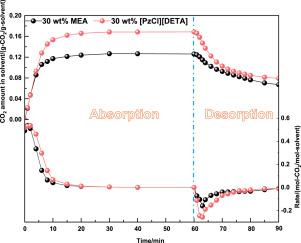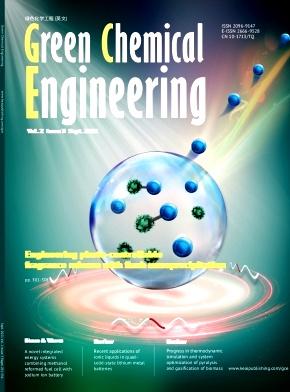Aqueous polyamine-based deep eutectic solvent: balancing stability, CO2 absorption/desorption performance, and post-absorption viscosity
IF 7.6
Q1 ENGINEERING, CHEMICAL
引用次数: 0
Abstract
Deep eutectic solvents (DESs) have gained significant attention as potential absorbents for CO2 capture due to their tunable physicochemical properties and environmental sustainability. However, achieving a balance of thermal stability, absorption/desorption performance, and viscosity remains a critical challenge for industrial applications. To address this, a novel aqueous polyamine-based DES system was developed using an ionic liquid with high stability–PzCl (piperazine chloride, P), as a hydrogen bond acceptor (HBA); a polyamine with multiple active sites, DETA (diethylenetriamine, D), as a hydrogen bond donor (HBD), and H2O as co-solvent. By systematically optimizing the molar ratio of PzCl to DETA, [PzCl][DETA] (PD) with a 1:5 molar ratio was identified as the optimal one based on the absorption capacity/rate, thermal stability, post-absorption viscosity, and desorption efficiency of its aqueous solution. Further investigation into the water content revealed that 30 wt% [PzCl][DETA] (1:5) effectively balanced the CO2 absorption capacity (0.168 g-CO2/g-absorbent) and desorption efficiency (54%), more outstanding than those of 30 wt% MEA (0.126 g-CO2/g-absorbent and 47%, respectively), and provided acceptable post-absorption viscosity (8.11 mPa·s), which was slightly higher than that of 30 wt% MEA (3.77 mPa·s) but lower than 10 mPa·s. These findings provide a scalable framework for designing sustainable absorbents that harmonize high performance with operational viability. This work bridges the gap between laboratory-scale innovations and industrial implementation in carbon capture technologies.

水聚胺基深共晶溶剂:平衡稳定性、CO2吸收/解吸性能和吸收后粘度
深共晶溶剂(DESs)由于其可调的物理化学性质和环境可持续性,作为二氧化碳捕获的潜在吸收剂受到了广泛的关注。然而,实现热稳定性、吸收/解吸性能和粘度的平衡仍然是工业应用的关键挑战。为了解决这一问题,研究人员开发了一种新型的基于聚胺的水基DES系统,该系统使用具有高稳定性的离子液体pzcl(氯化哌嗪,P)作为氢键受体(HBA);具有多个活性位点的多胺,DETA(二乙烯三胺,D)为氢键供体(HBD), H2O为助溶剂。通过对PzCl与DETA的摩尔比进行系统优化,通过对PzCl与DETA水溶液的吸附容量/速率、热稳定性、吸附后粘度和解吸效率的考察,确定了PzCl与DETA (PD)的摩尔比为1:5的最佳配比。进一步研究表明,30 wt% [PzCl][DETA](1:5)有效地平衡了CO2吸收能力(0.168 g-CO2/g-吸附剂)和解吸效率(54%),比30 wt% MEA (0.126 g-CO2/g-吸附剂和47%)更为突出,并提供了可接受的吸附后粘度(8.11 mPa·s),略高于30 wt% MEA (3.77 mPa·s),但低于10 mPa·s。这些发现为设计可持续吸收剂提供了一个可扩展的框架,以协调高性能和运营可行性。这项工作弥合了碳捕获技术在实验室规模创新和工业实施之间的差距。
本文章由计算机程序翻译,如有差异,请以英文原文为准。
求助全文
约1分钟内获得全文
求助全文
来源期刊

Green Chemical Engineering
Process Chemistry and Technology, Catalysis, Filtration and Separation
CiteScore
11.60
自引率
0.00%
发文量
58
审稿时长
51 days
 求助内容:
求助内容: 应助结果提醒方式:
应助结果提醒方式:


